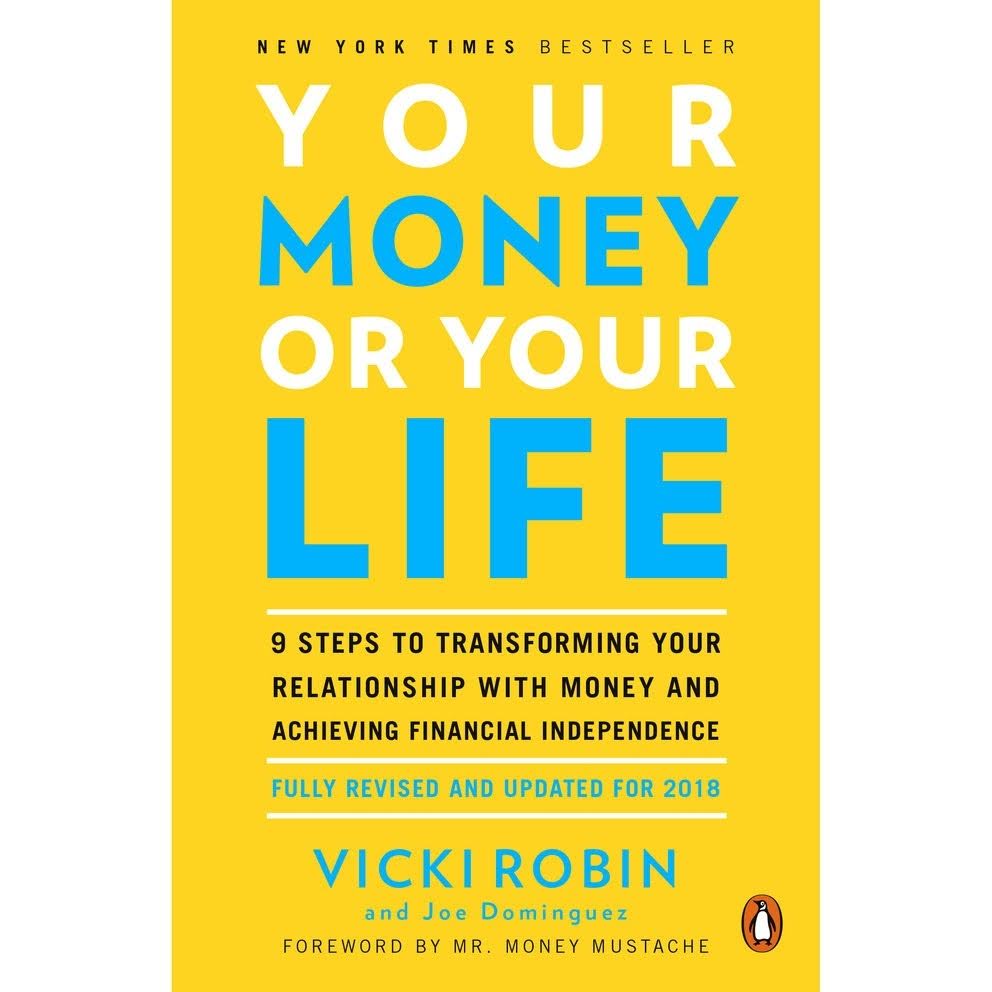Your Money or Your Life (1992) presents a nine-step roadmap for seizing command of your finances – allowing you to savor your existence instead of simply earning a livelihood. The book teaches you how to shift your perspective on your finances and time, get rid of debts, commence saving, and eventually achieve Financial Freedom.
- Attain Financial Freedom and retire early
- Reconcile with your financial past by envisioning your earnings and determining your net value
- The fundamental message here is: Reconcile with your financial past by envisioning your earnings and determining your net value
- Determine your genuine hourly wage, and monitor your finances
- Sort your monthly expenditures
- Assess the funds utilized in your subcategories
- Develop a wall diagram to monitor your progress
- Intentionally decrease or eradicate your expenses
- Appreciate your life vitality by boosting your earnings
- Generate revenue from your investments to realize Financial Independence
- Explore and select your investment avenues
- Synopsis
- About the author
Attain Financial Freedom and retire early
If faced with a life-threatening ultimatum where you have to surrender your money or risk your life, chances are, you would hand over your finances. However, in our day-to-day routines, many of us unknowingly prioritize money over life. We find ourselves trapped in a cycle of earning from our jobs to purchase unnecessary items, often sacrificing our true priorities in the process.
In these digests, you will uncover the journey to Financial Independence – the ability to choose how to allocate your time without depending solely on paid work. As you progress, you will gain a clear view of your financial past, free yourself from preconceptions about money, and cultivate fresh financial practices to eradicate your debts and potentially retire early.

Reconcile with your financial past by envisioning your earnings and determining your net value
If you’re akin to most individuals, you likely have scant insight into the total sum of money that has traversed your life. To gain control of your financial landscape, you must come to terms with your past financial dealings. Hence, the primary step in transforming your association with money and attaining Financial Independence is making peace with your monetary history.
Calculating the total wealth that has crossed your path helps in attaining a vivid understanding of both your financial saga and your bond with money. Perhaps you always believed that you were financially secure – however, this security may have been bolstered by others. Conversely, you might have assumed you earned meagerly, underestimating your historical income. In every scenario, comprehending your financial journey aids in reshaping your outlook on prospective earnings.
The fundamental message here is: Reconcile with your financial past by envisioning your earnings and determining your net value
To start off, assess the cumulative amount of your gross earnings over your lifetime. This figure should encompass all earnings from your initial paycheck to your most recent dime.
If you’re unsure where to commence, utilize records from the Social Security Administration, bank statements, or even old CVs to jog your memory on your earnings year by year. Ensure you adjust the total to incorporate unreported incomes like familial gifts, cash rewards, or under-the-table earnings. It’s imperative that the calculation remains truthful and precise.
After calculating your lifetime earnings, the subsequent step in reconciling with your financial past is determining your present net worth: your assets minus liabilities.
Compute your net worth by compiling a personal balance sheet tracking your assets and debts. Liquid assets encompass assets convertible into cash, such as funds in your savings and checking accounts, as well as stocks and bonds at their current market worth, and even loose change in your vehicle. Fixed assets encompass all possessions, ranging from significant items like your home or car to saleable items at a garage sale. Subsequently, compute your liabilities, comprising debts, loans, or unpaid invoices. Subtract this total from your combined assets to establish your net worth.
Determine your genuine hourly wage, and monitor your finances
We each have fewer than nine thousand hours annually – a sizable portion dedicated to slumber. Undoubtedly, time stands as our most valuable asset. Thus, when you head to work each day, you’re not just exchanging your time for a paycheck; you’re exchanging your life’s energy. Essentially, your spending equates to expending your life energy.
To reshape your relationship with money, it’s vital to question your assumptions regarding your earnings and expenditures. By doing so, you can conserve your life energy for endeavors that genuinely matter to you. Consequently, the program’s second stride emphasizes understanding your current situation by computing your authentic hourly wage and overseeing your finances.
The primary takeaway here is: Determine your genuine hourly wage and monitor your finances.
To determine your life-energy-to-earnings ratio, assess your actual hourly wage by discerning the total time and money invested in sustaining your occupation.
Commence by constructing a table with three sections. Label the first column as weekly hours, the second column as earnings, and the third column as dollars earned per hour. Subsequently, slot in the specifics based on your job. For instance, if working 40 hours weekly yields $1,000, you make $25 per hour.
Next, make allowances for any adjustments. If you commute to work, factor in the time taken for your commute alongside related costs like fuel, tolls, or public transportation fares. Account for funds spent on work attire and time expended on shopping, dressing up, or preening for work. Include the additional time and money devoted to meals, incorporating coffee breaks and takeout meals when cooking seems arduous or time-consuming. Also, integrate time or expenses linked to work-related illnesses or leisure activities used for unwinding post-work.
Reverting to your table, encompass all supplementary time in your weekly hours column. Then, deduct your expenses from your weekly earnings listed in the second column. Finally, determine your real hourly wage.
Armed with the knowledge of your genuine hourly wage, you can gauge the value of your life energy in spending. To comprehend your spending patterns thoroughly, commence recording every monetary transaction entering or exiting your life. By acknowledging your spending tendencies, you can base your spending decisions on actuality rather than perceived expenses.
Sort your monthly expenditures
Having gathered insights into your financial past and real hourly wage, it’s time to initiate progress toward adopting change. Rest assured, creating a budget isn’t mandatory. While budgets aid in planning, they often lack flexibility.
If not a budget, then what? It’s elementary: you must comprehend precisely how you utilize your money. The third step involves categorizing your monthly expenditures. Cluster your
Manage your costs in ways that align best with your preferences.
The main point to remember here is to classify your monthly expenditures.
Suppose you wish to oversee your food outlays. Based on your distinct way of life, you have the option to establish subgroups like “dinners for visitors,” “exhausted to cook,” or “snacking.” By closely monitoring the specific divisions of your expenses, you may come to realize that your sporadic restaurant dining has evolved into a fully-fledged, costly routine. Also, form subcategories to monitor your expenses on things like accommodation, commuting, and leisure activities.
After detailing your spending categories, set up a monthly calculation that outlines your subcategories. Include a segment at the end of the table to itemize your earnings — with individual rows for any wages, perks, dividends, or other income sources that may impact the total. Once you have input your monthly transactions into each division, deduct your overall spending from your total income to ascertain your monthly savings.
You might be taken aback to see the amount of money directed towards a specific subgroup — say, beauty items. But you will likely not be as surprised when you find yourself in another cosmetics store.
This is where the real power of the system comes into play. To assess how much of your vitality each subgroup incurs, divide the money spent on any given subgroup by your actual hourly wage computed in step two. Let’s assume you spend $80 on magazines that seldom get read, and your actual hourly wage amounts to $10. Realizing that you dedicated eight hours of your life energy to make the purchase might prompt you to think twice the next time you pass a magazine rack!
Assess the funds utilized in your subcategories
Take some time to contemplate what you would do if you were not obligated to work using a diary. What did you aspire to be when you were growing up? If you had just one more year to live, how would you allocate your time? Did you always dream of writing a book but currently find yourself engaged in copywriting professionally?
Remember, no aspiration is too grand. By making slight alterations to your spending habits, you are on your way to actualizing it. This leads us to the fourth phase in the program: appraising your spending by posing three queries to yourself.
The key point to remember here is to assess the funds utilized in your subcategories.
Review the monthly tabulation from Step 3 — do the life energy spent on each of your subcategories equate to the contentment and fulfillment you gained?
You may discover that in certain subcategories, you experienced such high satisfaction that you would even contemplate amplifying the expenditure of life energy. If that is the situation, mark the subgroup with a positive sign. For subcategories where you experienced negligible or no satisfaction, assign a negative sign. If the expense feels impartial, designate it as zero.
By objectively examining your spending, you may realize that you are skimping on subcategories that provide you value while overspending on addictive behaviors — such as purchasing footwear that hardly gets worn.
Secondly, does your utilization of life energy correspond with your life mission and principles? Suppose you expended 25 hours of life energy on dining out last month. You may discern that this mirrors your esteem for socializing or delectable cuisine; hence, you are content with the expenditure. Alternatively, you might acknowledge that this expense stems from a bad routine or peer pressure; it does not align with your principles or life mission. Once more, mark each subgroup with a positive, negative, or neutral sign to denote your evaluation.
Lastly, how would you alter your spending patterns if you were Financially Independent and did not need to earn an income? Would you purchase more or fewer garments? Allocate more or less on petrol? In numerous instances, you might realize that you are spending more money due to your profession than you would otherwise.
Develop a wall diagram to monitor your progress
Congratulations! You are midway along the journey to Financial Independence. Yet, if you have followed any program previously, you are aware that a fundamental part of the struggle is adhering to the plan. To ensure continued advancement towards your financial aims, you must guarantee that your fresh system is a routine rather than an option.
An effective method to ingrain a new practice is to hold yourself answerable to another individual. Perhaps you could contemplate sharing the outcomes of your financial progress with a companion or a relative.
However, the most paramount strategy for sustained success is monitoring your progress. This leads us to step five in the program: tracking your progress with a chart displaying your income and expenses.
The central theme here is to develop a wall diagram to monitor your progress.
On a spacious sheet of paper, sketch a chart that you can affix to your wall to follow your monthly income and expenses. The vertical axis denotes money, while the horizontal axis indicates time measured in months. When setting intervals on the vertical axis, commence with 0 and provide adequate room for your income to double. The horizontal axis measures your progress over a span of five to ten years.
At the conclusion of each month, use contrasting hues to document your monthly outgoings and earnings. Subsequently, link the data points to the entry from the previous month. Over the months and years, you will discern patterns and track your advancement towards your financial objectives.
While creating a chart on your computer might be tempting, having the chart on your wall acts as a continuous prompt to adhere to your plan. Consider Elaine H., a software developer who felt trapped in her occupation. Upon engaging in the program, Elaine recognized that she was spending more than she was earning. Consequently, she set up a wall chart and committed to refraining from purchasing clothes and dining out for a month.
Sure enough, her expenses for the subsequent month were notably lower than her income. However, after regressing to her previous behaviors, it did not take long for her expenses to escalate yet again. Observing the dip on the chart, Elaine was motivated to implement lasting changes. She relocated to a residence with lower rent that was closer to her workplace — reducing her fuel expenses by 60 percent. Additionally, she slashed her restaurant expenditure by over half simply by preparing meals more frequently. Within four months, Elaine was liberated from debt and on a sustainable path to Financial Independence.
Intentionally decrease or eradicate your expenses
In the contemporary era, the notion of being thrifty may appear unattractive or outdated. Present-day consumer culture has conditioned us to believe that more is better. Nevertheless, from the ancient teachings of Plato and Socrates to historic American personalities like Benjamin Franklin, Robert Frost, and Ralph Waldo Emerson, practicing thrift was deemed a virtue. And if your aspiration is to attain financial independence, you must grow accustomed to this concept.
Fundamentally, frugality entails relishing what you possess. If you own ten dresses and take pleasure in wearing them across the years — fantastic! Yet, if you are a compulsive buyer and merely indulge in acquiring dresses that remain unworn in your closet, it might be time to trim that expenditure. Now that you have gained insight into your fiscal past and present, step six of the program is to consciously reduce your monthly outlay.
The pivotal message here is: Intentionally decrease or eliminate your expenses.
Consciously scaling down or eliminating your spending involves judiciously utilizing your life energy. There exist several methods to curtail your expenses. The most blatant approach is to steer clear of shopping. If you do not frequent stores, you will not be enticed into impulsive purchases. To reduce theurge to shop online, opt-out from marketing emails, stay vigilant of promotions on social platforms, and establish a routine of purchasing only essential items.
However, cutting down on expenditures doesn’t imply becoming a bargain enthusiast. Instead of selecting the most inexpensive option available, consider investing in a more long-lasting product. For instance, if you buy a $40 tool that lasts a decade rather than a $30 tool that only lasts five years, you’ll end up saving $20 in the long run. Look into acquiring single items that can fulfill multiple functions — purchase a sturdy pot instead of separate rice cooker, pasta cooker, and a Crock-pot.
At times, there might be categories you are reluctant to eliminate from your lifestyle. This is where creativity comes into play. Take Harry, for example, as he contemplated discontinuing his household cleaning and gardening services to trim expenses. Harry wasn’t inclined to handle the house chores himself. Thus, he transformed his seldom-used dining room into a studio apartment for renting out to a couple in exchange for yard and house maintenance. Harry was content to have the work taken care of by others, and the couple found a way to cut down on their housing costs.
Appreciate your life vitality by boosting your earnings
The concept of a 40-hour workweek is a contemporary Western notion.
During the Industrial Revolution, the advent of new manufacturing techniques led to a segregation between work hours and leisure time. Working conditions deteriorated to such an extent that workers eventually advocated for a shorter workweek. However, leisure time transformed from a period of rest to an opportunity to enhance productivity as a worker.
Subsequently, during the Great Depression, spare time became associated with joblessness. This attitude from the Depression era continues to reverberate through Western society in the present day. The work-centric lifestyle prevalent in our society has become so overwhelming that campaigns like “Take Back Your Time” have gained traction in challenging our perception of work.
The pivotal message here is: Enhance your life energy by increasing your earnings.
Society endeavors to persuade us that dedicating 40 hours a week to work is essential to being fully contributing members. However, the primary purpose of employment is actually to earn money. Aspects such as community, potential for growth, or recognition can all be experienced outside of conventional job settings. Therefore, it’s high time we reassess how we allocate our life energy.
The seventh step to revolutionizing your money management and attaining Financial Independence centers on valuing your life energy and boosting your income. Reflect on this: Is the life energy you are currently investing in your job an equitable trade-off for what you are getting in return?
Whether you are saving for graduate school, supporting your family, or clearing debts, aiming for the highest feasible remuneration in alignment with your well-being and ethics isn’t merely about desiring more money for the sake of it. It’s about striving for a sustainable future. If you require $2,500 to cover your expenses, you could double your income by earning $50 hourly as a freelancer as opposed to remaining in your $25 per hour desk job.
In certain scenarios, increasing your income might entail working additional hours in the short term. While Rosemary relished her role as the director of a retirement facility, her genuine passions lay in travel, writing, and environmental activism. Recognizing that transitioning to a higher-paying job could introduce more stress detracting from her objectives, Rosemary secured a supplementary position with a small audio distribution firm during evenings and weekends. Even though she was working over 40 hours weekly, the awareness that she was advancing toward her Financial Independence aspiration kept her motivated.
Generate revenue from your investments to realize Financial Independence
For many individuals, the notion of early retirement appears to be a luxury reserved for a select few. However, a burgeoning movement known as FIRE, or Financial Independence Retire Early, reveals otherwise. Advocates of the FIRE movement have gleaned a simple truth: by investing your savings, your funds will eventually generate adequate returns for you to retire and engage in activities that truly matter to you. The key is to amass adequate monthly investment earnings.
Unlike the earnings derived from your job, your monthly investment revenue is the income received from your capital. This encompasses any income acquired without direct labor — such as interest, dividends, rental payments, or business proceeds.
The crucial message here is: Generate revenue from your investments to attain Financial Independence.
Prior to commencing investment activities, ascertain that you have enough funds in your bank to cover six months of expenses. This liquid cash serves as your emergency fund as well as the source from which you’ll draw for your monthly expenditures.
Once you have at least six months’ worth of liquid capital in your bank account, contemplate opening a savings account. This paves the way for the eighth step in the program: investing and monitoring your supplementary savings.
To compute your monthly investment earnings, multiply your capital, or your extra savings, by your prevailing long-term interest rate — this is the sum you can anticipate from a prolonged investment. This data can be gleaned by checking the ongoing 30-year yield of US Treasury bonds through sources like the Wall Street Journal.
Subsequently, divide the outcome by 12. Once you’ve executed the formula, chart the result as a fresh line on your visualization board alongside the lines tracking your income and expenses. Keep in mind, the vertical axis denotes your finances, while the horizontal axis marks the passage of time.
While your monthly investment income may seem inconsequential in the initial phases, with consistent income and expenditure patterns, you’ll eventually be able to prognosticate the funds required to achieve Financial Independence.
Over time, your invested funds will lead to an upward curve on the graph. By observing this pattern lightly, you can pinpoint the juncture at which your monthly investment income surpasses your monthly expenditures. This crossover point is your milestone. For most individuals, this milestone materializes when your savings equal 25 times your annual expenditure. If your average annual outlay amounts to $36,000, then you’ll necessitate $900,000 in assets to reach Financial Independence.
Explore and select your investment avenues
Now that you’ve calculated your milestone and the goal of attaining Financial Independence appears feasible, you must become well-versed in enduring, income-generating investment methods. Financial advisors, dubious brokers, and salesmen will strive to sway your investment decisions while charging hefty commissions. Evade redundant charges by middlemen and empower yourself to make informed investment choices!
Your investment revenues may encompass rental income from real estate or royalties from intellectual assets, franchises, or natural reserves. You might amass capital by selling an investment for an amount higher than your initial input. However, it’s probable that you’ll center on earning interest or dividends through investments in bonds, mutual funds, or the stock exchange.
The vital message here is to explore and select your investment avenues.
When coauthor Joe Dominguez retired at 31 in 1969, he had achieved Financial Independence by investing in US Treasury bonds. During the following decades, high interest rates meant that he, alongside tens of thousands of other individuals who invested in US Treasury bonds, secured enduring Financial Independence.
Conversely, since the beginning of the millennium, interest rates have waned. Today, the majority of FIRE bloggers recommend investing in low-cost index funds. Index funds represent exchange-traded funds, or ETFs. These are mutual funds that mirror the performance of stock or bond market indices. Rather than outperforming the market or cherry-picking individual stocks, index funds embody a passive strategy diversifying your investments across a broad range of trading activities. They entail minimal risk with low fees — making them a preferred choice for anyone treading the path to Financial Independence.
If you are employed at a firm offering a retirement scheme, such as a 401(k), your savings will likely be supervised by major brokerage firms providing mutual or bond funds. Opting for this option could be advantageous; numerous companies match the investments you make.
In any scenario, it’s imperative to explore all your options before embarking on an investment journey. By making well-informed decisions, you’ll ensure that your investments mirror the sustainability of your updated approach to time and money management. You’ll be leading a more purposeful life even before reaching your monetary targets.
Synopsis
The central themes echoed in these synopses include:
Commence your quest towards Financial Independence by analyzing your financial past alongside your present monetary condition. Overhauling your association with money entails recognizing that the income you earn from your job is equivalent to your life vitality. Trim your expenses, boost your earnings, and invest your savings to retire early, settle debts, and realize your financial aspirations.
About the author
Vicki Robin is an American author and orator. Following Robin’s appearance on the Oprah Winfrey Show, her book Your Money or Your Life swiftly became a best seller; it has crossed the one million mark in copies sold.
Joe Dominguez was a financial analyst on Wall Street prior to his retirement at 31. He devised the nine-step program delineated in Your Money or Your Life.


